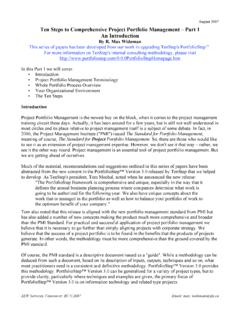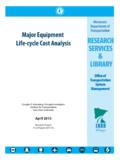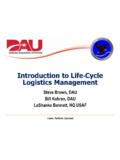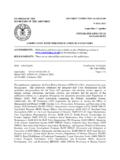Transcription of 11/17/07 The Project Management Life Cycle By Jason ...
1 11/17/07 AEW Services, Vancouver, BC 2007 Email: The Project Management life Cycle By Jason Westland (A book review by R. Max Wideman) Introduction Editor's Note: We liked so much of this book that we asked for the author's permission to quote extensively from the whole of Jason Westland's Chapter 1. This is because it succinctly describes what follows in detail in the remainder of the book. However, in pursuing our regular book review structure, we placed his text under corresponding headings. Since the quotations are so extensive, we have not followed our normal practice of indenting quoted paragraphs. However, the references are identified in the footnotes. As Jason says: "Welcome to The Project Management life Cycle . This book describes the Methodl23 Project Management Methodology (MPMM)1 and provides a practical approach to managing projects. Every phase, activity and task in the Project life Cycle is described here in detail to help you manage staff, customers and suppliers efficiently.
2 By reading this book, you will gain the knowledge and confidence required to properly initiate a Project , create detailed Project plans, build high quality deliverables, monitor and control delivery and close projects effectively. "Not only will you learn how to successfully complete projects from end to end, but you will also be armed with a suite of tools and templates to allow you to create Project deliverables quickly and easily. More than 150 charts, tables and diagrams are included in this book to help explain the steps needed to undertake a Project . Each table is full of real life examples to provide you with the knowledge needed to complete Project activities faster than before."2 Book Structure The book structure is very simple, yet it covers a lot of ground in only 237 pages. Jason explains it as follows. "The Project life Cycle "The Project life Cycle consists of four phases as shown in Figure 1.
3 "As there are four phases within the Project life Cycle , there are four main chapters in this book. Each of these chapters describes a particular Project life Cycle phase in detail, by providing the activities and tasks required to complete the phase in its entirety. In Chapter 2 you will learn how to initiate projects by developing a business case, undertaking a feasibility study, establishing the terms of reference, appointing the team and setting up a Project office. "Every step required to build a comprehensive suite of Project plans is provided in Chapter 3. This includes the activities required to create a Project plan, resource plan, financial plan, quality plan, risk plan, acceptance plan, communications plan and procurement plan. The entire tender process is also defined, allowing you to create a suite of tender documentation to help you select a preferred supplier and create a supplier contract.
4 The Project Management life Cycle Page 2 of 10 AEW Services, Vancouver, BC 2007 Email: Figure 1: The four phases of the Project life cycle3 "The most complex phase in the Project life Cycle ( Project execution) is made simple in Chapter 4 with a step by step guide to the nine critical Management processes: time Management , cost Management , quality Management , change Management , risk Management , issue Management , procurement Management , acceptance Management and communications Management . "Finally in Chapter 5, you will be shown how to formally close a Project by creating a Project closure report and undertaking a post implementation review. So sit back, relax and discover the vital steps needed to manage a Project through the four critical phases of the Project life Cycle : initiation, planning, execution and closure."4 What we liked Project Initiation Jason says: "The first phase of a Project is the initiation phase.
5 During this phase a business problem or opportunity is identified and a business case providing various solution options is defined. Next, a feasibility study is conducted to investigate whether each option addresses the business problem and a final recommended solution is then put forward. Once the recommended solution is approved, a Project is initiated to deliver the approved solution. Terms of reference are completed outlining the objectives, scope and structure of the new Project , and a Project manager is appointed. The Project manager begins recruiting a Project team and establishes a Project office environment. Approval is then sought to move into the detailed planning phase." 5 "Within the initiation phase, the business problem or opportunity is identified, a solution is defined, a Project is formed and a Project team is appointed to build and deliver the solution to the customer.
6 Figure shows the activities undertaken during the initiation phase: Figure 2: Project initiation activities "Develop a business case: The trigger to initiating a Project is identifying a business problem or opportunity to be addressed. A business case is created to define the problem or opportunity in detail and identify a preferred solution for implementation. The business case includes: A detailed description of the problem or opportunity; The Project Management life Cycle Page 3 of 10 AEW Services, Vancouver, BC 2007 Email: A list of the alternative solutions available; An analysis of the business benefits, costs, risks and issues; A description of the preferred solution; A summarized plan for implementation. "An identified Project sponsor then approves the business case and the required funding is allocated to proceed with a feasibility study. "Undertake a feasibility study: At any stage during or after the creation of a business case, a formal feasibility study may be commissioned.
7 The purpose of a feasibility study is to assess the likelihood of each alternative solution option achieving the benefits outlined in the business case. The feasibility study will also investigate whether the forecast costs are reasonable, the solution is achievable, the risks are acceptable and the identified issues are avoidable. "Establish the terms of reference: After the business case and feasibility study have been approved, a new Project is formed. At this point, terms of reference are created. The terms of reference define the vision, objectives, scope and deliverables for the new Project . They also describe the organization structure; and activities, resources and funding required to undertake the Project . Any risks, issues, planning assumptions and constraints are also identified. "Appoint the Project team: The Project team are now ready to be appointed. Although a Project manager may be appointed at any stage during the life of the Project , the manager will ideally be appointed prior to recruiting the Project team.
8 The Project manager creates a detailed job description for each role in the Project team, and recruits people into each role based on their relevant skills and experience "Set up a Project office: The Project office is the physical environment within which the team is based. Although it is usual to have one central Project office, it is possible to have a virtual Project office with Project team members located around the world. A Project office environment should include: Equipment, such as office furniture, computer equipment, stationery and materials; Communications infrastructure, such as telephones, computer network, e mail, Internet access, file storage, database storage and backup facilities; Documentation, such as a Project methodology, standards, processes, forms and registers; Tools, such as accounting, Project planning and risk modeling software. "Perform a phase review: At the end of the initiation phase, perform a phase review.
9 This is basically a checkpoint to ensure that the Project has achieved its objectives as planned." 6 What we liked Project Planning Jason continues: "Once the scope of the Project has been defined in the terms of reference, the Project enters the planning phase. This involves creating a: Project plan outlining the activities, tasks, dependencies and timeframes; Resource plan listing the labor, equipment and materials required; Financial plan identifying the labor, equipment and materials costs; Quality plan providing quality targets, assurance and control measures; Risk plan highlighting potential risks and actions to be taken to mitigate those risks; The Project Management life Cycle Page 4 of 10 AEW Services, Vancouver, BC 2007 Email: Acceptance plan listing the criteria to be met to gain customer acceptance; Communications plan describing the information needed to inform stakeholders; Procurement plan identifying products to be sourced from external suppliers.
10 "At this point the Project will have been planned in some detail and is ready to he executed." 7 "By now, the Project costs and benefits have been documented, the objectives and scope have been defined, the Project team has been appointed and a formal Project office environment established. It is now time to undertake detailed planning to ensure that the activities performed during the execution phase of the Project are properly sequenced, resourced, executed and controlled. The activities shown in Figure 3 are undertaken. Figure 3: Project planning activities "Create a Project plan: The first step in the Project planning phase is to document the Project plan. A 'work breakdown structure' (WBS) is identified which includes a hierarchical set of phases, activities and tasks to be undertaken to complete the Project . After the WBS has been agreed, an assessment of the level of effort required to undertake each activity and task is made.










